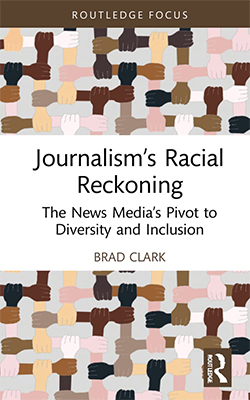New book by MRU journalism prof puts media’s reckoning with equity, diversity and inclusion in spotlight
Analysis a tool for students, instructors and news-gathering industry
— Mount Royal University | Posted: June 20, 2022

Brad Clark was surprised by just how many examples he found of poor coverage of racialized groups and toxic workplace culture in media, despite the proudly progressive ethos of the news industry.
The summer of 2020 was a time of reckoning for institutions the world over, and the need for reform and facing institutional racism extended to those who covered the Black Lives Matter Movement — the news media.
In a new book, Journalism’s Racial Reckoning: The News Media’s Pivot to Diversity and Inclusion, MRU Broadcast Media Studies associate professor Dr. Brad Clark, PhD, addresses endemic issues of racism in news media as journalists around the world continue to speak out against prejudice and inequality in the industry.
The events of 2020 — the death of George Floyd and the rise in prominence of the Black Lives Matter movement, in particular — have drawn new and focused attention to inequality, white supremacy and systemic racism, including in the media. The book, published by Taylor & Francis Ltd., chronicles this racial reckoning, revisiting and examining the issues it has raised.
“When George Floyd was murdered, I started to follow the rise of BLM and anti-racism, and the way our social institutions were being called out. When it started happening with the news industry I really took notice,” says Clark, formerly a national reporter with CBC. “Racialized and Indigenous journalists started speaking out and also writing about their experiences of racism in newsrooms and the wider industry. I started collecting those accounts, mostly out of personal interest, but also as potential resources for my classes. Over the summer and fall of 2020, more and more journalists stepped forward to express their concerns and call for reform. I decided to try and write about it, first as an academic paper, and then as a book.”
Clark analyzed media output by racialized and Indigenous journalists, identifying the racial make up of newsrooms; the dominance of white perspectives in news coverage; interpretations of ethics downplaying systemic racism and bias; ignorance of racist history in editorial decisions and news content; and diversity and inclusion measures.
“Objectivity as an expression of journalistic independence, of non-partisanship, has a place in news gathering. But objectivity — as with most journalistic ideals and norms — evolved out of colonialism and the settler state,” Clark observes. “The objective view in journalism has been a white, patriarchal view. Thus, at different points in the history of North American journalism, ‘objective’ reporting has made the case for truly racist policies, including residential schools, head taxes, slavery and segregation, internment camps, racist immigration policies and Bill 21 in Quebec. In practice, objectivity has frequently stood in the way of perhaps an even more important journalistic ideal — truth.”

Journalism’s Racial Reckoning: The News Media’s Pivot to Diversity and Inclusion is intended as a resource for students and scholars of journalism, journalism ethics, sociology, cultural studies, organizational studies, media and communication studies.
Journalism’s Racial Reckoning details actions taken by news organizations to address long-standing issues with racism in news content and newsrooms. While some did nothing, others started creating real space in their newsrooms and in their content for diverse voices. Clark points out that newsrooms have been predominantly white, despite decades of diversity initiatives. He notes that a number of organizations conducted diversity audits and source audits to assess participation rates for different groups among their staff and the people they cover. Some went a step further and started releasing those statistics publicly.
“There was also lots of reconsideration about the way issues related to race have typically been covered. Sometimes there was a showy flourish to the measures, attempting to build goodwill with audiences by announcing all the good things companies were doing. I think the most notable measures, though, came from a handful of news organizations that acknowledged their own failings, highlighted their racist coverage of the past, and then apologized and promised to do better. That looked like real accountability to me.”
That said, Clark was surprised by just how many examples he found of poor coverage of racialized groups and toxic workplace culture in media, despite the proudly progressive ethos of the news industry. Those cases support the arguments being put forward by Indigenous and racialized journalists.
“We still live in a racist society. We're not ‘post-racial’ as some have tried to argue,” Clark says. “There's already been a tremendous backlash to the so-called racial reckoning, especially in the U.S. when you look at all the legislation targeting Critical Race Theory and the LGBTQ2S community. We need to keep pushing an anti-racist, human rights agenda to make journalism an effective force for equity.”
Journalism’s Racial Reckoning is intended as a resource for students and scholars of journalism, journalism ethics, sociology, cultural studies, organizational studies, media and communication studies.
“Brad's work provides both journalism educators and students a critical, transparent, and unapologetic look at the collective failures of news media that have operated with white-led models of practice,” says Sally Haney, associate professor and chair of Journalism and Digital Media and Broadcast Media Studies at MRU.
“A respected journalist and researcher, Brad's work takes the reader on a show-don't-tell journey, where startling examples in our recent history help us to understand what's at risk if the news media doesn't get its act together on the diversity and inclusion fronts. The great news is the book also leaves space for moving forward.”

